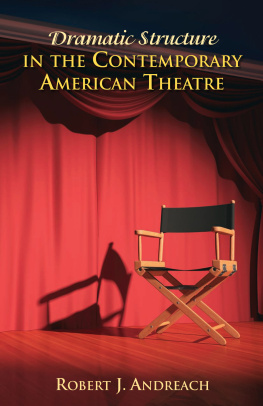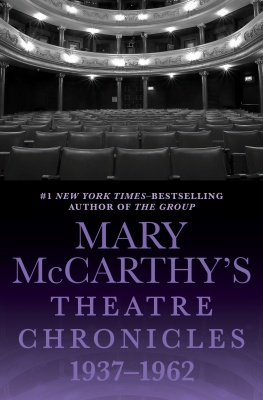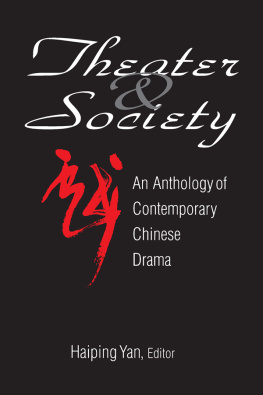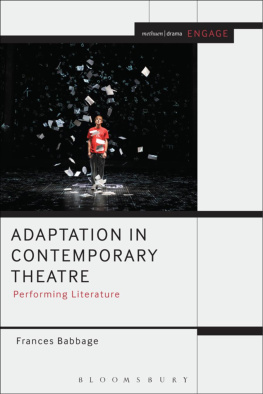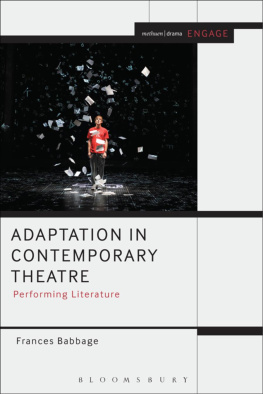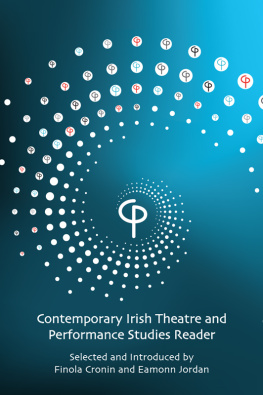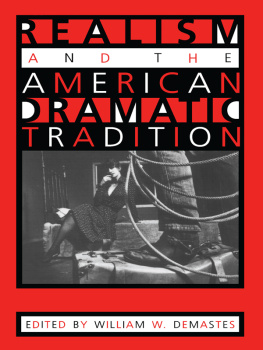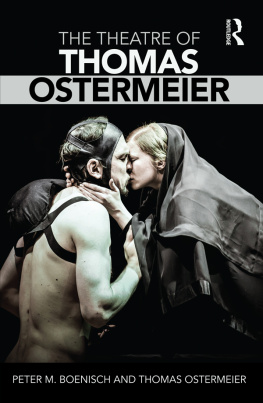Andreach - Dramatic Structure in the Contemporary American Theatre
Here you can read online Andreach - Dramatic Structure in the Contemporary American Theatre full text of the book (entire story) in english for free. Download pdf and epub, get meaning, cover and reviews about this ebook. City: Santa Fe;New Mexico, year: 2018, publisher: SCB Distributors;Terra Nova Books, genre: Romance novel. Description of the work, (preface) as well as reviews are available. Best literature library LitArk.com created for fans of good reading and offers a wide selection of genres:
Romance novel
Science fiction
Adventure
Detective
Science
History
Home and family
Prose
Art
Politics
Computer
Non-fiction
Religion
Business
Children
Humor
Choose a favorite category and find really read worthwhile books. Enjoy immersion in the world of imagination, feel the emotions of the characters or learn something new for yourself, make an fascinating discovery.
- Book:Dramatic Structure in the Contemporary American Theatre
- Author:
- Publisher:SCB Distributors;Terra Nova Books
- Genre:
- Year:2018
- City:Santa Fe;New Mexico
- Rating:4 / 5
- Favourites:Add to favourites
- Your mark:
- 80
- 1
- 2
- 3
- 4
- 5
Dramatic Structure in the Contemporary American Theatre: summary, description and annotation
We offer to read an annotation, description, summary or preface (depends on what the author of the book "Dramatic Structure in the Contemporary American Theatre" wrote himself). If you haven't found the necessary information about the book — write in the comments, we will try to find it.
Andreach: author's other books
Who wrote Dramatic Structure in the Contemporary American Theatre? Find out the surname, the name of the author of the book and a list of all author's works by series.
Dramatic Structure in the Contemporary American Theatre — read online for free the complete book (whole text) full work
Below is the text of the book, divided by pages. System saving the place of the last page read, allows you to conveniently read the book "Dramatic Structure in the Contemporary American Theatre" online for free, without having to search again every time where you left off. Put a bookmark, and you can go to the page where you finished reading at any time.
Font size:
Interval:
Bookmark:
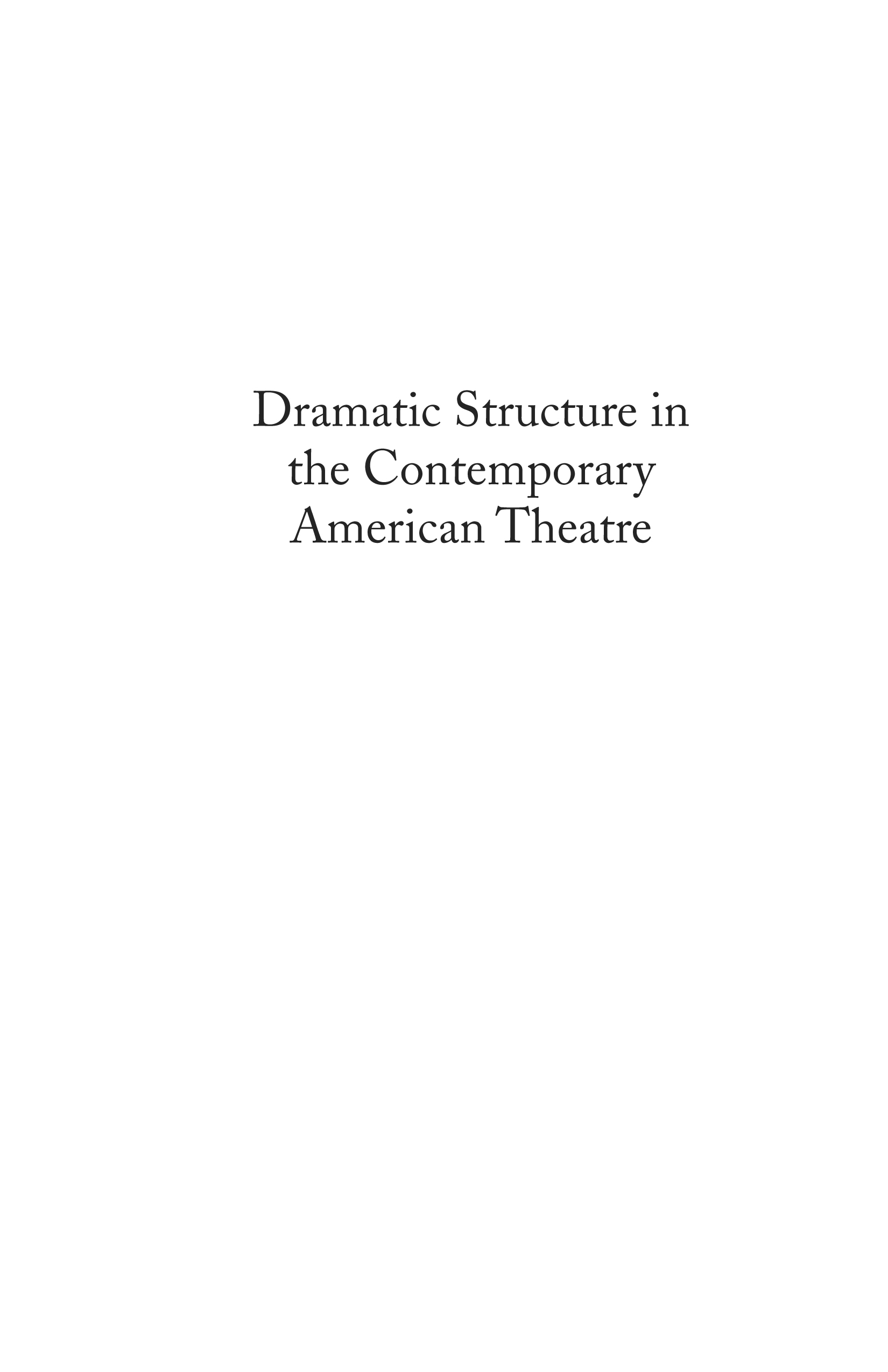
Other books by Robert J. Andreach
Tragedy in the Contemporary American Theatre (2014)
The Contemporary American Dramatic Trilogy:
A Critical Study (2012)
Len Jenkins Theatre: Wonder and Heart (2010)
John Guares Theatre: The Art of Connecting (2009))
The War Against Naturalism:
In the Contemporary American Theatre (2007)
Understanding Beth Henley (2006)
Drawing Upon the Past: Classical Theatre in
the Contemporary American Theatre (2003)
Creating the Self in the Contemporary American Theatre (1998)
The Slain and Resurrected God: Conrad, Ford, and
the Christian Myth (1970)
Studies in Structure: The Stages of the Spiritual Life in
Four Modern Authors (1964))

Library of Congress Control Number 2017955933
Distributed by SCB Distributors, (800) 729-6423

Dramatic Structure in the Contemporary American Theatre.
Copyright 2018 by Robert J. Andreach
All rights reserved
Printed in the United States of America
No part of this book may be used or reproduced in any manner whatsoever without written permission except in the case of brief quotations embedded in critical articles and reviews. Send inquiries to Terra Nova Books, 33 Alondra Road, Santa Fe, New Mexico 87508.
Published by Terra Nova Books, Santa Fe, New Mexico.
www.TerraNovaBooks.com
ISBN 978-1-938288-39-5
For Kevin, Jason, and Thelma; George and Elaine;
and Jim (in memoriam) and Mary
Contents
Preface
T his book began as a continuation of The Contemporary American Dramatic Trilogy published in 2012. At that time, as I noted in the introduction, I could not include examinations of other trilogies. The example given was John Patrick Shanleys trilogy. In a 2006 interview, he gave the reason for the non-inclusion. He had not completed a third segment to go with the first two segments: Doubt and Defiance. Since Storefront Church was produced in 2012, an examination of his trilogy is now included. An example not given was Quiara Alegra Hudes trilogy, for although the second segment, Water by the Spoonful, was awarded the Pulitzer Prize in 2012, the premiere of the third segment, The Happiest Song Plays Last, was scheduled for 2013. An examination of her trilogy is also now included. A missing segment is not the sole explanation for the non-inclusion. After the first volume was published, I discovered trilogies that predated the 2012 publication: Wallace Shawns A Thought in Three Parts and By the Sea By the Sea By the Beautiful Sea by Joe Pintauro, Lanford Wilson, and Terrence McNally. The first originated in the 1970s, the second in the 1990s. A third reason for inclusion in the second volume is a completed trilogy within a projected larger work. Like Horton Footes nine-part Orphans Home Cycle performed as three trilogies in 200910 and examined in the first study, Suzan-Lori Parks nine-part Father Comes Home from the Wars had its first three parts performed in 2014.
Another reason for the second study is the genres popularity. In fiction, Suzanne Collins The Hunger Games Trilogy spawned a movie version. If non-American English-speaking fiction is added, Australian E.L. James Fifty Shades Trilogy spawned both a movie version and a musical parody. On the internet, Empire lists the thirty-three greatest movie trilogies as voted for by you, the Empire readers. Numbers 1 and 2 are The Lord of the Rings and The Original Star Wars Trilogy.
To return to the contemporary theatre: in a four-month period in 2010, Time Out New York gave notice of productions of segments of planned trilogies by Robert Askins about life in Waco, by Gary Ferrar about metatheatrical flights, by Jay Scheib about simulated cities, and by Oren Safdie about architecture. Examples of contemporary Irish plays are Tom Murphys Alice Trilogy and Seamus Scanlons The McGowan Trilogy. In 2014, a company mounted the three parts of Shakespeares rarely performed Henry VI. In 2014, New Yorks La MaMa Theater hosted, though not on one program, a trilogy of works inspired by Shakespeares The Tempest: an American, a South Korean, and an Italian. In the same year, contemporary British playwright David Hare created the Worricker Trilogy for television viewing. If the genres popularity is extended to collaborative works, though not three parts each by a different playwright, Theatre 167 had eighteen playwrights write the Jackson Heights Trilogy: a dramatic exploration of a diverse neighborhood in New York Citys Queens borough.
Finally, the bedrock for inclusion remains the same as that for the first volume. The trilogy is a tripartite work that develops dramatically. That does not mean a linear narrative with a resolution in closure. It does mean a progression through the segments that would exclude Alan Ayckbourns The Norman Conquests, were the work American, because the plays can be performed in any order. Performance art such as John Eppersons Lypsinka! The Trilogy is also excluded, as is a work currently engaging performance artist Lee Breuer, the first segment of which, La Divina Caricatura, La MaMa Theater presented in December 2013.
Although begun as a continuation, unlike the first book, whose primary objective was establishing the genre, this study concentrates on structure, and the reason for the single concentration has to do with the way in which most trilogies are performed. I saw Adam Rapps The Hallway Trilogy in what is called a marathon viewing. Instead of seeing the three segments on different weekday evenings, I chose all three on a Sunday, but that meant an intermission between the first two segments for coffee in a cafe and a second intermission for dinner in a restaurant. Even if the three segments of Sarah Ruhls Passion Play and Parks Father Comes Home from the Wars: Parts 1, 2 & 3 had been offered on separate evenings, I still would have opted for the way I saw them, the three together, but these examples are the exception rather than the rule. Since the majority of trilogies consist of three full-length plays, the theatregoer does not experience the three in one sitting, and the time gap can create a problem.
The longer the time before the third segment completes the trilogy, the more fuzzy the theme running through it can become in the theatregoers mind. He/She therefore concludes that the first segment established the theme. In the case of Hudes trilogy, whose first segment, which premiered in 2006, is Elliot, A Soldiers Fugue and whose protagonist is wounded in the Iraq War, the conclusion is that the theme has something to do with the Iraq War. War figures in the action, but a study of the structure completed in The Happiest Song Plays Last, which premiered in 2013, reveals another theme that would be apparent were the three segments experienced in a marathon viewing.
During a 2007 conversation about the state of the American theatre, playwrights Rapp and Gina Gionfriddo commented on the dearth of plays about the Iraq War. Both thought that one explanation was the theatres desire to entertain audiences, even if that meant importing British plays, prompting Gionfriddo to suggest that a David Rabe play would be a revival thats gonna speak to our current war in Iraq. Rapp exclaimed, Yes!
Font size:
Interval:
Bookmark:
Similar books «Dramatic Structure in the Contemporary American Theatre»
Look at similar books to Dramatic Structure in the Contemporary American Theatre. We have selected literature similar in name and meaning in the hope of providing readers with more options to find new, interesting, not yet read works.
Discussion, reviews of the book Dramatic Structure in the Contemporary American Theatre and just readers' own opinions. Leave your comments, write what you think about the work, its meaning or the main characters. Specify what exactly you liked and what you didn't like, and why you think so.

